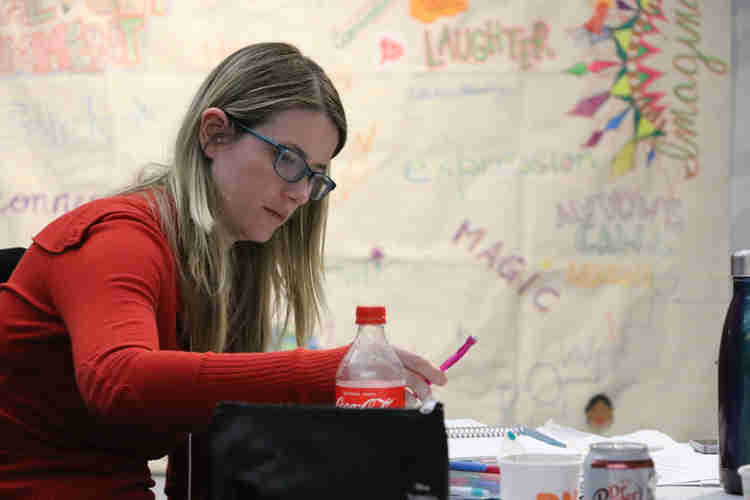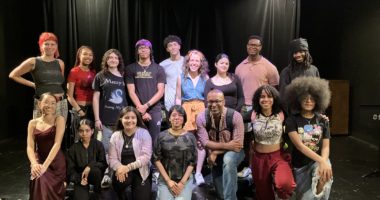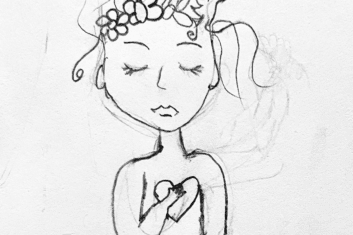

Sara Knudson was born, raised, and attended university in Sacramento, CA. Her first short story was written about a horse, and she has spent the last twenty years riding, training, and teaching students how to ride horses. With an interest in communication, whether it be silent kinesthetic communication between horse and rider, or a story conveyed through language, Sara decided to move to NYC to pursue writing and teaching the craft of writing in greater depth. She attends Sarah Lawrence College, where she is pursuing her MFA in speculative fiction. TAP is her first Teaching Artist program and internship, and she has enjoyed translating her previous teaching skills and experiences into the classroom setting. Her current writing projects are a short story collection and a science fiction novel.


TAP Work:
Having teaching experience outdoors, but none in a classroom, Sara shifted her entire perspective through the Teaching Artist Program from hierarchical to decolonized teaching techniques that engage the individual and generate autonomous learning. At P.S. 279, she interned with Teaching Artists Rachael Schefrin and Erin Anderson, whose residency combined theatre and poetry for 1st graders to generate their own creation myth that engaged their individual backgrounds, origins, and sensibilities. Using her own background with music, kinesthetic learning, and language, Sara developed and led a lesson with Erin to teach rhythm in words to the 1st graders. She also attended ASTEP’s Teaching the Arts to Emerging English Speakers seminar, and collaborated on a teaching artist path with peer Teaching Artist Program participant Melissa Liu. In their collaborative lesson plan, they focused on communication in visual and linguistic forms as a means of engaging with and as a community.


Most Memorable TAP Moment:
“There were several impactful moments, both in workshop sessions and my internship. Watching my peer TAP participants present their sample lesson plans was such an eye-opening experience. The breadth of methods and creativity that can be used to convey a lesson are endless, and the conversations these presentations started were intelligent and thoughtful. Another big moment was teaching my first lesson in the classroom. I was so impressed during my internship with how Rachael and Erin (my TA mentors) managed to balance attention and learning with fun engagement while never losing track of time or goals for their lesson. Both by watching their methods, intuition, and adaptability and getting a chance to engage with the students directly myself, I gained so many tools. At the same time, I learned how much more there is to learn, which is why I’m so grateful to be part of this community that shares experiences in a supportive environment.”
Find out more about Sara here:


“The Wanderer” by Sara Knudson
You’d think I’d hear it rattling around on the wood floor, see it, maybe. It’s too large to get trapped behind things, and yet it does all too frequently. It can’t blend into the furniture with its baby blue marbled surface, or sneak with the little beans rattling around inside its plastic shell. But I’d lost the rattler so many times, picked it up and replaced it, and yet it found its way outside my purse, around corners.
I found it once in the freezer, iced over and cold enough for teething. I chased it over lego minefields, around a corner, where it tried to outrun me. I found it floating in the pool, creeping toward the filter where it might have become stuck and lost forever. I dropped it and watched it bounce down the stairs, the sound sharp and breakable. It found its way into the toaster one day as I tried to butter toast. It hovered precariously on the sill of my open second-story window. I found it near the butcher knives in the kitchen, and startled so suddenly that I squirted ketchup all over it.
I expect it to wander out the door soon, climb a bus and disappear in exhaust fumes. I expect it roll away to college and careen down terrifying roads, blinded by headlights and beer. I imagine it will move states and never come back.
And then I find it in a cupboard, sitting next to canned red beans and a package of rice. I cup it in hand and return it to the empty nursery where it will not stay with the other dusty items, too independent, too driven to wander out into the woods, to the creek, and float away.



